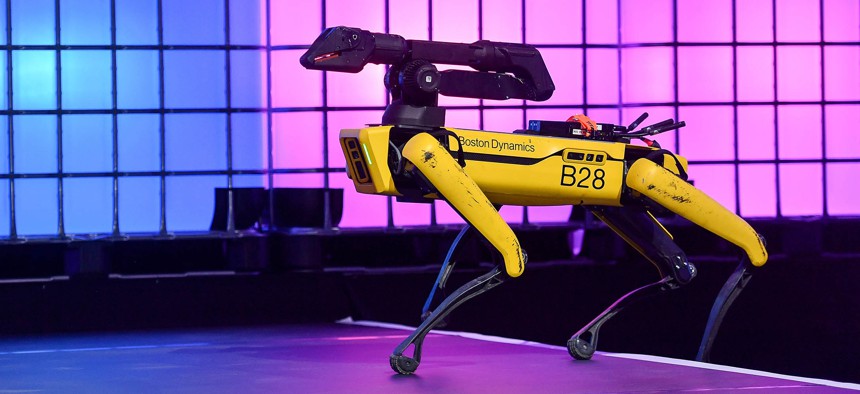Robots enlisted for public safety missions

Spot, Boston Dynamics, Robot, on Centre Stage during the final day of Web Summit 2019 at the Altice Arena in Lisbon, Portugal. GettyImages/ Sam Barnes / Contributor

Connecting state and local government leaders
State and local responders are rolling out robots to help with situational awareness, disaster response and remote patrol.
Public safety organizations are introducing robots to help with situational awareness, disaster response and remote patrol.
Just this week, the Los Angeles Police Department used a bomb disposal robot to move a package with suspicious writing found outside of a Los Angeles Fire Department station. The robot was tasked with moving the package away from the station and onto the street. After the package was determined to be safe, an officer was seen moving it onto a median.
Last month, the New York Fire Department became the first fire agency to purchase Boston Dynamics’ Spot robot for its search and rescue missions.
During emergencies, the Spot robot can provide vital information to its human operator and other first responders, a NYFD robotics unit official told the New York Times. The robots can collect data and images in environments too dangerous for public safety personnel. They can venture into debris after a steam or leak to measure the level of toxic, flammable gasses like carbon monoxide or into a collapsed building to determine structural integrity.
Other state and local agencies deploying public safety robots include:
The Honolulu Police Department used a Spot robot during the pandemic to patrol the city’s Keehi Lagoon Beach Park homeless encampment and take the temperature of individuals living there. Police say the decision to use robots was a precautionary measure to protect law enforcement officials from those who may have contracted the virus while living in the encampment. According to a HPD pitch for the technology reported by Vice, the department expected to the robot to save between $117,000 and $242,760 over 90 days. Avoided costs included not paying for foot patrols and the expenses related to quarantine of an officer who is exposed to COVID.
The Minneapolis Police Department is looking to put 4Sight’s tactical robots in every squad patrol car. Essentially a stripped-down remote-control vehicle, each 11-pound robot comes with built-in, super-bright LEDs and a clip mount for officers to hook up their phones. The mounting clip can hold a body-worn camera, or another cell phone using video communications software like Facetime or Zoom. Officers can use the robots for surveillance operations in buildings, backyards or other environments, allowing them to peek around corners and talk to hostages or perpetrators through the phone’s video feed. With this, the responding officer is not put in harm’s way and through sharing the video feed, law enforcement can also seek outside counsel from command staff for more informed decisions.
Robots helped with search and rescue missions in Florida: three building collapses, two mine disasters and an earthquake. Drones gave responders aerial views so they could map the scope of the disaster. Images from the drones helped responders plan the search for survivors, answering critical questions about the location of potential victims and possible fires. With ground robots fitted with sensors, cameras and microphones and speakers, responders could determine whether anyone was trapped in the rubble, and medical personnel could see, talk and deliver supplies to survivors.
Bomb squads and law enforcement officers responding to suspicious packages have also deployed robots. In 2019, Massachusetts State Police tested the Spot robots for “remote inspection of potentially dangerous environments which may contain suspects and ordinances," per the agreement between the state’s Office of Public Safety and Security and Boston Dynamics. A police spokesman said the technology provided police with valuable situational awareness and could preserve lives.
Private-sector security teams are also looking to robots for security. Autonomous security robots have been enlisted to patrol Liberty Village, an apartment complex in Las Vegas and a medical campus on the Sunset Strip in Los Angeles. Manufactured by Silicon Valley-based Knightscope, the cone-shaped robot stands five feet tall and uses a plethora of sensors and four internal cameras to capture a 360-degree view of its surroundings. With high quality infrared cameras, the K5 can scan and record license plates, and onboard wireless technology enables it to identify the MAC and IP addresses of cell phones within range, according to a report in Muckrock. A company source said the robot has contributed to a “significant drop in 911 calls” from Liberty Village, a frequent source of emergency calls.
As more governments adopt robots, critics have voiced concerns about privacy and over-aggressive policing along with questions about the benefits.
Without specific, detailed examples of crimes and incidents diverted by the robots, experts question their effectiveness. Proponents do not disagree, but they say that robots still provide overall benefits to communities.
“Are we seeing dramatic changes since we deployed the robot in January?” Dena Lerner, a spokesperson for the owner of the Las Vegas apartment complex, told NBC News. “No. But I do believe it is a great tool to keep a community as large as this, to keep it safer, to keep it controlled.”




